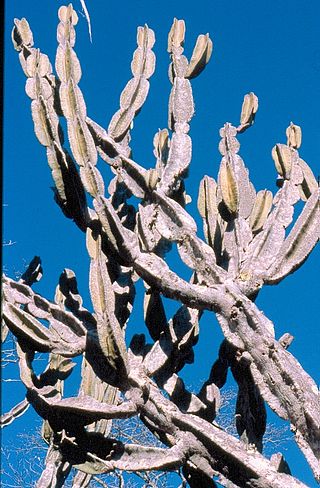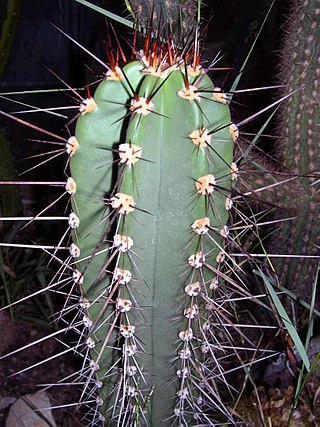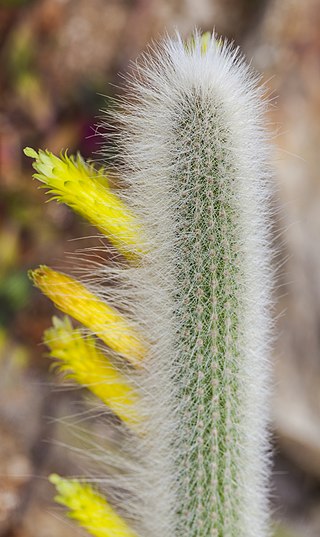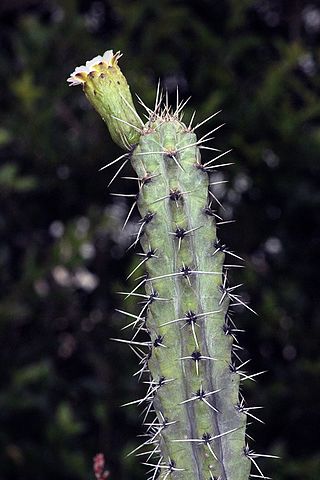
Stetsonia coryne, the toothpick cactus, is the sole species in the cactus genus Stetsonia. Stetsonia coryne grows to a height of 15 to 25 ft tall. It has white flowers.

Cleistocactus hyalacanthus is a species of columnar cacti in the genus Cleistocactus. The name comes from the Greek kleistos meaning closed because the flowers hardly open.

Pachycereus pecten-aboriginum is a columnar cactus plant native to Mexico. They can grow up to 15 m (49 ft) high. The trunk of this species is 1.2 to 5.0 m tall and the fruits are large and burr-like. The specific name, pecten-aboriginum, is from the Latin, and means "native combs". It was inspired by the use of the fruits as hair combs.

Cereus aethiops is a species of cactus found from Uruguay to Argentina.

Cereus phatnospermus, synonym Cereus kroenleinii, is a species of columnar cactus found in Brazil, Bolivia, and Paraguay.

Cereus vargasianus is a species of columnar cactus found in Peru.

Cereus hexagonus or lady of the night cactus is a species of columnar cactus found in Ecuador and Venezuela.

Cereus stenogonus, also known as narrow-angled cereus, is a species of Cereus found in Bolivia, Paraguay and Argentina.

Cereus pierre-braunianus is a species of columnar cactus found in NE Goiás in Brazil.

Cereus lanosus or is a species of columnar cactus found in Central, Cordillera, Concepción, and Paraguarí departments of Paraguay. The plant is found growing in rocky hills at elevations of 250 and 300 meters.

Mirabella estevesii, synonym Cereus estevesii, is a species of columnar cactus found in Minas Gerais, Brazil. The first description was published in 2004 by Pierre Josef Braun as Cereus estevesii.

Mirabella albicaulis, synonym Cereus albicaulis, is a species of flowering plant in the family Cactaceae, native to Northeast and Southeast Brazil. It was first described by Britton and Rose in 1920 as Acanthocereus albicaulis.

Neoraimondia arequipensis, synonym Neoraimondia macrostibas, is a tree-like cactus native to western Peru. It was first described in 1835 as Cereus arequipensis.

Neoraimondia herzogiana is a tree-like cactus native to Bolivia.

Armatocereus procerus is a species of Armatocereus found in southern Peru.

Cleistocactus ritteri is a species of Cleistocactus found in Bolivia.

Cleistocactus smaragdiflorus is a species of Cleistocactus found in Bolivia and Argentina.

Xiquexique tuberculatus is a plant species in the genus Xiquexique from the cactus family. It is commonly called "Caxacubri".

Xiquexique gounellei is a species of plant in the genus Xiquexique of the cactus family. Common names include "Alastrado", "Chique-Chique", "Xique-Xique" and "Xique-Xique das Pedras".

Matucana aureiflora is a species of Matucana found in Peru.





















